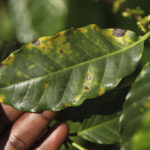
The Hawai`i Department of Agriculture (HDOA) has confirmed the detection of coffee leaf rust (CLR) on Kaua’i and Moloka`i. This coffee plant pathogen has now been found on all major Hawaiian Islands.
On June 28, 2021, a commercial coffee grower in Kilauea, Kaua`i, reported a possible CLR infection. HDOA collected samples and CLR was confirmed on July 9, 2021. Preliminary assessments indicate that CLR had been on Kaua`i for at least six months.
On June 14, 2021, HDOA staff conducted a survey of feral coffee plants on Moloka`i . A low-level infestation was detected on two coffee plants in a field of 50 wild coffee plants in Kaunakakai and CLR was confirmed on June 23, 2021. Subsequent surveys detected more infestations on the east side of the island. It is estimated that the infestation on the east side had been there for at least three months.
CLR was first detected in the state in October 2020 on Hawai`i Island and Maui and subsequently detected on O`ahu and Lana`i in January 2021.
Since the first detection, the Hawai`i Board of Agriculture (Board) approved an interim administrative rule which restricted the movement of coffee plants, plant parts and other CLR hosts from infected islands to try to stop the spread of the disease. With the detection of CLR statewide, HDOA is reassessing these restrictions; however, they will remain in place until further action is taken by the Board or the interim rule lapses in November 2021.
CLR is a serious coffee pathogen and was first discovered in Sri Lanka in 1869 and can cause severe defoliation of coffee plants resulting in greatly reduced photosynthetic capacity. Depending on CLR prevalence in a given year, both vegetative and berry growth are greatly reduced. There are multiple long-term impacts of CLR, including dieback, resulting in an impact to the following year’s crop, with estimated losses ranging from 30 percent to 80 percent.
AP Photo